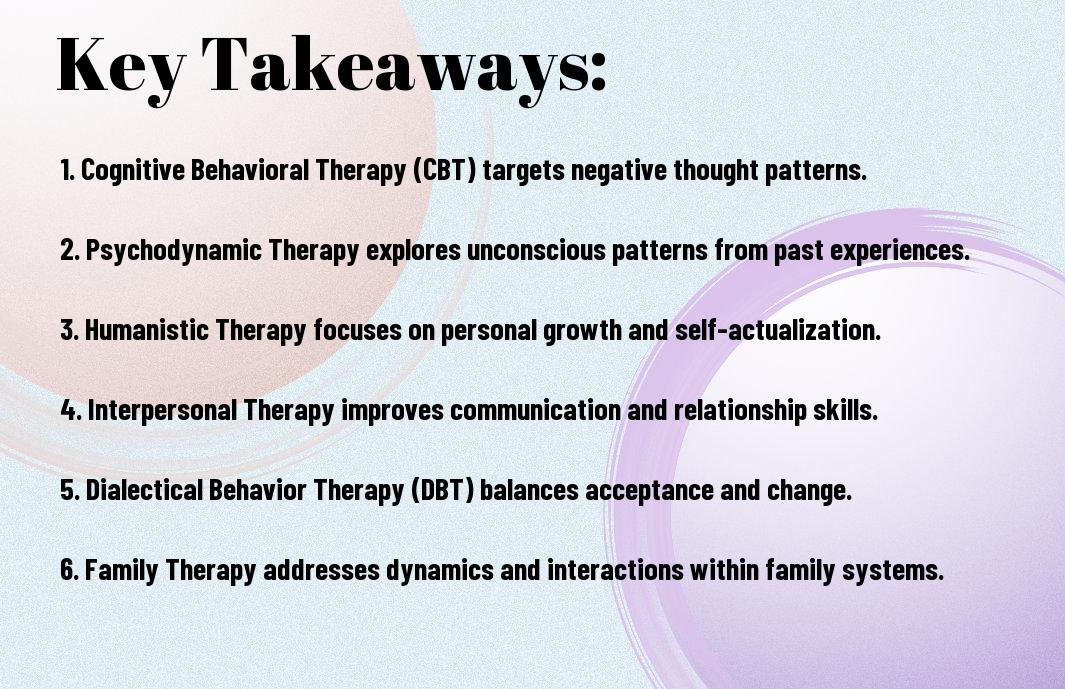Psychotherapy is a powerful tool that psychologists use to help individuals navigate and overcome mental health challenges. There are various types of therapy approaches that psychologists offer, each tailored to address specific issues and cater to different needs.
In this blog post, we will explore some of the most common types of therapy that psychologists use in their practice, helping you gain a better understanding of the possibilities available for your mental well-being.
Table of Contents
Key Takeaways:
- Cognitive-Behavioral Therapy (CBT): Focuses on changing negative thought patterns and behaviors to improve mood and coping skills.
- Psychodynamic Therapy: Explores unconscious thoughts and experiences to understand and resolve conflicts.
- Humanistic Therapy: Emphasizes personal growth, self-actualization, and the importance of the present moment.
- Interpersonal Therapy: Focuses on improving relationships and communication skills to address specific problems.
- Family Therapy: Involves working with the entire family to address issues and improve communication and relationships.
Exploring the Purpose of Therapy
Why People Seek Therapy
While there are various reasons why individuals seek therapy, the most common ones include dealing with mental health issues such as anxiety, depression, or trauma. Seeking therapy can also help individuals navigate major life changes like divorce, loss of a loved one, or career transitions.
The Goals of Psychological Therapy
Therapy aims to help individuals develop healthy coping mechanisms, improve their mental well-being, and enhance their overall quality of life.
The ultimate goal of psychological therapy is to empower individuals to create meaningful and positive changes in their lives.
To achieve these goals, psychologists work collaboratively with clients to identify underlying issues, set achievable goals, and develop strategies to address challenges and promote personal growth.
Therapy provides a safe and supportive space for individuals to explore their thoughts, emotions, and behaviors in a non-judgmental environment.
Popular Types of Therapy
Assuming you’re considering seeking therapy, it’s vital to understand the different types of therapy psychologists offer. Below are some popular types of therapy that are commonly used to help individuals navigate their mental health challenges:
Types of Therapy:
Cognitive Behavioral Therapy (CBT)
Cognitive Behavioral Therapy (CBT) is a widely-used therapeutic approach that focuses on identifying and changing negative thought patterns and behaviors.
It is based on the idea that our thoughts, feelings, and actions are interconnected, and by changing one, we can influence the others. CBT is often used to treat conditions such as anxiety, depression, and phobias.
In CBT sessions, the therapist works with the individual to challenge and reframe their negative thoughts and develop coping strategies to deal with challenging situations.
This therapy is usually short-term and goal-oriented, making it an effective option for individuals looking for practical tools to manage their mental health.
Psychodynamic Therapy
On the other hand, Psychodynamic Therapy is a form of therapy that focuses on exploring the unconscious mind and its influence on current behaviors.
This type of therapy is rooted in the idea that our past experiences and relationships shape our present thoughts and actions. Uncovering and understanding unconscious patterns, individuals can gain insight into their emotions and behaviors.
Understanding Psychodynamic Therapy:
Humanistic Therapy
What sets Humanistic Therapy apart is its emphasis on self-exploration, personal growth, and self-actualization. This therapeutic approach focuses on the individual’s potential to make positive choices and lead a fulfilling life.
Humanistic therapists provide a supportive and non-judgmental environment where individuals can explore their feelings and desires.
This therapy aims to help individuals build self-awareness, improve self-esteem, and enhance their relationships with others.
Humanistic Therapy is often used to address issues such as low self-esteem, identity crisis, and a lack of fulfillment in life.
Therapy for Different Age Groups
Therapy for Children and Adolescents
Keep in mind that therapy for children and adolescents is tailored to suit their developmental needs and emotional understanding.
Therapists use a variety of techniques such as play therapy, art therapy, and cognitive-behavioral therapy to help young individuals express themselves and learn coping mechanisms.
One important aspect of therapy for children and adolescents is building trust and rapport with the therapist.
Creating a safe and non-judgmental environment allows them to open up about their thoughts and feelings, leading to positive outcomes in their mental well-being.
Therapy for Adults
The therapy approaches for adults vary depending on the individual’s needs and the issues they are facing. Some common types of therapy include psychodynamic therapy, mindfulness-based therapy, and solution-focused therapy.
Adults seek therapy for a wide range of reasons such as anxiety, depression, relationship issues, and life transitions.
The therapy process for adults involves setting goals, exploring thought patterns and behaviors, and developing skills to better manage stress and other challenges.
It provides a space for self-reflection and personal growth, empowering individuals to make positive changes in their lives.
Therapy for Older Adults
Understanding the unique needs of older adults is crucial in providing effective therapy. Older adults may face issues such as grief, loss, chronic illness, and isolation, which can impact their mental health.
Therapists specializing in geriatric therapy focus on enhancing the quality of life for older adults and promoting emotional well-being.
Dynamics such as addressing generational differences, exploring life transitions in later stages, and incorporating a holistic approach to therapy are important when working with older adult clients.
Building a supportive and trusting relationship is key to successful therapy outcomes for this age group.
Specialized Therapy Modalities
All psychologists specialize in various therapy modalities to cater to the diverse needs of their clients. Whether you are seeking therapy for yourself, as a couple, or as a family unit, there are specialized modalities available to address your specific concerns.
Marriage and Family Therapy (MFT)
To strengthen relationships and improve communication within families or couples, Marriage and Family Therapy (MFT) can be highly effective.
Therapists who specialize in MFT focus on understanding the dynamics within relationships and offer tools and strategies to promote healthier interactions.
Art and Music Therapy
To tap into the expressive and creative aspects of therapy, Art and Music Therapy can be incredibly beneficial.
These modalities allow individuals to explore their emotions and experiences through artistic expression or musical engagement, providing a unique avenue for self-discovery and healing.
Plus, Art and Music Therapy can be particularly helpful for individuals who may struggle to verbalize their feelings or memories.
The act of creating art or making music can bypass traditional communication barriers and facilitate emotional processing in a non-verbal way.
Eye Movement Desensitization and Reprocessing (EMDR)
One specialized therapy modality that has gained popularity for treating trauma and phobias is Eye Movement Desensitization and Reprocessing (EMDR).
This innovative approach involves bilateral stimulation, such as eye movements or hand taps, to help reprocess distressing memories and alleviate emotional distress.
Seeking EMDR therapy from a trained psychologist can provide a unique and effective way to address traumatic experiences and reframe negative beliefs, leading to profound healing and growth.
Therapy in the Digital Age
Online Therapy Platforms
To meet the growing demand for accessible mental health support, many psychologists now offer online therapy platforms. These platforms allow individuals to connect with licensed therapists from the comfort of their own home.
This convenient option provides flexibility for those with busy schedules or mobility limitations, making therapy more accessible than ever before.
Technological Advancements in Therapy
To further enhance the therapy experience, technological advancements in therapy have revolutionized the way psychologists offer mental health support.
Platforms now offer features such as video conferencing, messaging systems, and therapy apps that provide tools for self-reflection and progress tracking.
These advancements help therapists personalize treatment plans and engage with clients in new and innovative ways.
Types of therapy offered through these platforms range from traditional talk therapy to more specialized approaches like cognitive-behavioral therapy and mindfulness-based therapy. Psychologists are leveraging technology to create a supportive and interactive environment that fosters healing and growth in their clients.
Navigating the Therapist-Patient Relationship
Despite the varying approaches and techniques therapists use, the therapist-patient relationship is a key factor in the success of therapy. Building a strong connection with your therapist is important for creating a safe and supportive environment for your healing journey.
Establishing Trust with Your Therapist
On your first session with a therapist, it’s normal to feel nervous or hesitant. Opening up to a stranger about personal issues can be daunting, but remember therapists are trained professionals who are there to help you.
Building trust takes time, so don’t feel pressured to share everything at once. Take it at your own pace and gradually, as you start feeling comfortable, you can examine deeper into your thoughts and emotions with your therapist.
Understanding Therapeutic Techniques and Boundaries
Therapy involves a range of techniques such as cognitive-behavioral therapy, psychodynamic therapy, and humanistic therapy. Each therapist may use a combination of these techniques based on your needs and goals.
It’s important to communicate openly with your therapist and understand the boundaries of the therapeutic relationship. Therapists are there to guide and support you, but they can’t solve your problems for you.
They can equip you with tools and strategies to navigate challenges, but ultimately, the work of healing and growth lies with you.
Establishing a positive and trusting relationship with your therapist is imperative for a successful therapeutic journey. Being open, honest, and willing to engage in the process, you can create a safe space for exploration and healing.
Overcoming the Stigma of Therapy
Unlike in the past, seeking therapy is now widely accepted and encouraged as a way to improve mental health and overall well-being. However, the stigma surrounding therapy still exists, which can prevent some individuals from seeking the help they need.
Common Misconceptions About Therapy
Misconceptions about therapy are common and can make individuals hesitant to seek help. Some believe that therapy is only for people with severe mental illnesses, while others think it is a sign of weakness.
In reality, therapy is for everyone and can help with a wide range of issues, from everyday stressors to more significant mental health challenges.
How to Advocate for Mental Health Awareness
Mental health awareness is crucial in breaking down the stigma surrounding therapy. Starting conversations, sharing personal experiences, and educating others about the benefits of therapy, we can help normalize seeking help for mental health concerns.
Additionally, supporting mental health initiatives and spreading positivity about therapy can create a more accepting and understanding environment for those in need.
Overcoming the stigma of therapy requires collective effort and a commitment to promoting mental health awareness. Challenging misconceptions, advocating for therapy, and fostering a supportive community, we can create a world where seeking help for mental health is seen as a positive and empowering step towards self-care and well-being.

Summing up
Thus, psychologists offer a wide range of therapy options to address various mental health concerns. Understanding the different types of therapy available, individuals can work with their therapists to find the approach that best suits their needs.
Whether it’s cognitive-behavioral therapy, psychoanalytic therapy, or humanistic therapy, each approach has its own unique benefits and applications. To learn more about the different approaches to psychotherapy, you can visit Different approaches to psychotherapy.
FAQ
Q: What is psychotherapy?
A: Psychotherapy, also known as talk therapy, is a way to help people with a broad variety of mental illnesses and emotional difficulties. It involves talking to a trained therapist to understand and address your feelings, thoughts, and behaviors.
Q: What are the different types of therapy psychologists offer?
A: Psychologists offer various types of therapy, including cognitive-behavioral therapy, psychodynamic therapy, humanistic therapy, and more. Each type of therapy has its own unique approach and techniques.
Q: What is cognitive-behavioral therapy (CBT)?
A: Cognitive-behavioral therapy is a type of therapy that focuses on helping individuals identify and change negative thought patterns and behaviors. It is effective in treating a wide range of conditions, such as anxiety, depression, and phobias.
Q: What is psychodynamic therapy?
A: Psychodynamic therapy is a form of therapy that explores how unconscious thoughts and past experiences influence current behavior. It helps individuals gain insight into their emotions and relationships to address underlying issues.
Q: How do I choose the right type of therapy for me?
A: It’s important to consider your specific needs and goals when choosing a type of therapy. You can discuss your preferences with a psychologist or therapist to determine which approach aligns best with your needs and personality.







